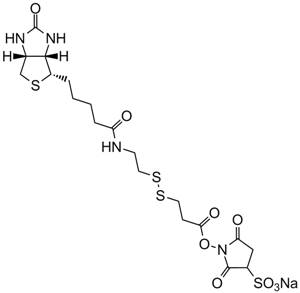Sulfo-NHS-SS-Biotin |
| Catalog No.GC14824 |
Sulfo-NHS-SS-biotin is an amine-reactive biotinylating reagent.
Products are for research use only. Not for human use. We do not sell to patients.

Cas No.: 325143-98-4
Sample solution is provided at 25 µL, 10mM.
Sulfo-NHS-SS-biotin is an amine-reactive biotinylating reagent.Sulfo-NHS-SS-biotin contains a negatively charged sulfonic acid group, giving it enough intramolecular polarity to be added directly to reactive aqueous solutions without the need for prior dissolution in organic solvents. Sulfo-ns-ss-biotin reacts with amine-containing proteins or other molecules to form a complex that further interacts with avidin or streptomycin probes to purify the target molecules by affinity chromatography[1].Sulfo-NHS-SS-biotin can be used for the biotinylation of plasma membrane proteins[5]. Amino groups on plasma membrane proteins are reversibly biotinylated by sulfo-NHS-SS-biotin. sulfo-NHS-SS-biotin contains a short spacer arm that includes a disulfide bond that can be cleaved by the addition of the membrane-impermeable reducing agent glutathione to cells[3,4].
Sulfo-NHS-SS-biotin crosslinker is an advantageous reagent for the analysis of lysine rich sequences by MALDI-MS because of its versatility. Prevention of trypsin cleavage after lysine residues leads to a higher sequence coverage and thus increases the chance to detect posttranslational modifications[2].
In MDA-MB-468 cell, The cell surface abundance of β1 integrin was examined by biotinylation(sulfo-NHS-SS-biotin ) and affinity precipitation[1]. To obtain a comprehensive view of the cell surface proteome of bone marrow-derived hMSCs,an analytical pipeline relying on cell surface biotinylation of intact cells using cell impermeable, cleavable sulfo-NHS-SS-biotin to enrich the plasma membrane proteins and mass spectrometry for identification with extremely high confidence. Among the 888 proteins identified, we found 200 bona fide plasma membrane proteins including 33 cell adhesion molecules and 26 signaling receptors. A significant difference between the cell surface proteome of hMSCs and that of human embryonic stem cells[6]. To localize the site(s) of action of DDM at the absorptive surface of Caco-2 cells, sulfo-NHS-SS-biotin, a membrane-impermeable compound, was applied apically. In the presence of 0.5 mM DDM, translocated biotin was found to be accumulated toward bicellular contacts, whereas no biotin permeation was observed in untreated control cells[7]. A dedicated protocol based on specific purification of surface membrane proteins labeled with sulfo-NHS-SS-biotin was developed. Appropriate gel electrophoresis separation and purification methods combined with standard proteomic methods were then used to identify and quantify surface membrane proteins from immature and mature spermatozoa. Membrane-associated proteins were discriminated from integral membrane proteins by differential solubilization. Protein regionalization on the spermatozoon surface was achieved by comparative analysis of the surface protein extracts from the entire spermatozoa and from periacrosomal sperm plasma membranes[8].
References:
[1]. Jo M, Eastman BM, et,al. Cell signaling by urokinase-type plasminogen activator receptor induces stem cell-like properties in breast cancer cells. Cancer Res. 2010 Nov 1;70(21):8948-58. doi: 10.1158/0008-5472.CAN-10-1936. Epub 2010 Oct 12. PMID: 20940399; PMCID: PMC2970644.
[2]. Markoutsa S, Bahr U, et,al. Sulfo-NHS-SS-biotin derivatization: a versatile tool for MALDI mass analysis of PTMs in lysine-rich proteins. Proteomics. 2014 Mar;14(6):659-67. doi: 10.1002/pmic.201300309. PMID: 24449390.
[3]. Walseng E, Furuta K, et,al. Ubiquitination regulates MHC class II-peptide complex retention and degradation in dendritic cells. Proceedings of the National Academy of Sciences of the United States of America. 2010 Nov;107(47):20465-20470. DOI: 10.1073/pnas.1010990107. PMID: 21059907; PMCID: PMC2996684.
[4]. Cho KJ, Walseng E, et,al. Ubiquitination by March-I prevents MHC class II recycling and promotes MHC class II turnover in antigen-presenting cells. Proc Natl Acad Sci U S A. 2015 Aug 18;112(33):10449-54. doi: 10.1073/pnas.1507981112. Epub 2015 Aug 3. PMID: 26240324; PMCID: PMC4547296.
[5]. Cho KJ, Roche PA. Monitoring MHC-II Endocytosis and Recycling Using Cell-Surface Protein Biotinylation-Based Assays. Methods Mol Biol. 2019;1988:271-277. doi: 10.1007/978-1-4939-9450-2_19. PMID: 31147946; PMCID: PMC8259318.
[6]. Niehage C, Steenblock C, et,al. The cell surface proteome of human mesenchymal stromal cells. PLoS One. 2011;6(5):e20399. doi: 10.1371/journal.pone.0020399. Epub 2011 May 26. PMID: 21637820; PMCID: PMC3102717.
[7]. Gradauer K, Iida M, et,al. Dodecylmaltoside Modulates Bicellular Tight Junction Contacts To Promote Enhanced Permeability. Mol Pharm. 2017 Dec 4;14(12):4734-4740. doi: 10.1021/acs.molpharmaceut.7b00297. Epub 2017 Oct 27. PMID: 28985076.
[8].Belleannee C, Belghazi M, et,al. Purification and identification of sperm surface proteins and changes during epididymal maturation. Proteomics. 2011 May;11(10):1952-64. doi: 10.1002/pmic.201000662. Epub 2011 Apr 7. PMID: 21472858.
Average Rating: 5 (Based on Reviews and 30 reference(s) in Google Scholar.)
GLPBIO products are for RESEARCH USE ONLY. Please make sure your review or question is research based.
Required fields are marked with *




